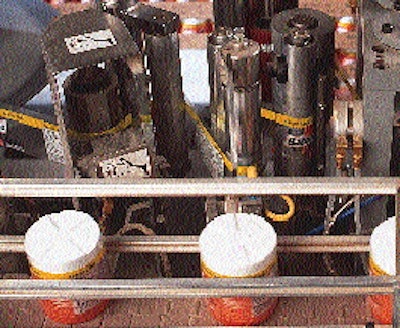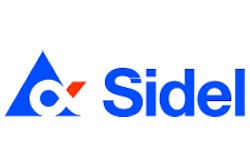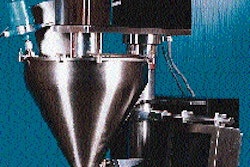When Chicago-based Gatorade Co., a unit of Quaker Oats, developed its new ribbed drink mix container to spur sales, it wanted a label that would best show off the ribbed design. Quaker and its contract manufacturer/packager, Power Packaging (St. Charles, IL), learned that shrink sleeve applicating equipment wouldn't be fast enough to satisfy production demands. So the companies turned to a unique combination of wraparound/shrink labels from CMS Gilbreth (Trevose, PA). That solution provides the look and tamper-evidence of a shrink sleeve with the high line speeds of a wraparound labeler. Launched in April (see PW, June '96, p. 83), the 18.4-oz high-density polyethylene container from Liquid Container (West Chicago, IL) replaces a composite can. The container is extrusion blown from Chevron's (Houston, TX) 9416 homopolymer resin to replicate the look of Gatorade's famous sidelines cooler often seen at pro sporting events. Thanks to that cooler, "we have instant recognition by consumers for this package," says Jeff Marsh, assistant brand manager for Quaker Oats Beverages North America. The package is topped by a white polypropylene screw cap from White Cap (Downers Grove, IL) that's injection-molded to look like the top of the sidelines cooler. The label consists of oriented polypropylene that's flexo-printed in six colors. CMS reverse-prints a 1-mil OPP web and then laminates it to a clear 1-mil OPP web to "bury" the ink in between for abrasion protection. "This is one of their basic structures," says Tracy Guard, associate scientist, packaging R&D for Quaker Oats Worldwide Beverages. "There's nothing unique about it." Still, even with the extra laminating step and the additional cost of the adhesive required for the labeler, Quaker Oats confirms that shrink OPP labels are actually less expensive than PVC sleeves for this application. However, there is a trade-off, according to Dan Williams, new business development manager at CMS Gilbreth: "With PVC, you can get nice-looking shrink quality-every container will look exactly the same. With an oriented polypropylene wraparound label, there will be small variations but there are tremendous cost savings." He also points out that there's a visible glue seam with the wraparound label. "We offered Quaker Oats both options." The wraparound label ultimately was selected, but it was not without its difficulties. The ribs on the container make it a challenge to guide the label onto the container. The perforation required some experimentation as well-the film needs to be cut in a precise manner to enable the cap to release at the desired torque when it's removed. From a graphic design standpoint, part of the challenge was to keep label graphics to a minimum to expose as much of the ribs as possible. "The trade-off is flavor differentiation," says Quaker's Marsh. Each of the seven different flavors is differentiated by a colored band and copy at the top. "If not for the ribs, we might have been more aggressive in alerting which flavor is which." The speed factor To get the high line speeds Quaker Oats sought, shrink sleeve applicating equipment simply wasn't fast enough. "We looked at some shrink band equipment, but we would only get 65 or 70 a minute for this size container," says Gary Gross, senior engineer at Power Packaging, which built an entirely new line for this package at its St. Charles, IL, facility. Says Rick Sims, plant manager: "Instead of one piece of equipment we'd be running three." In contrast, a wraparound labeler-specifically a Trine 4500(TM) from CMS Gilbreth From the time Gatorade gave Power Packaging the okay to proceed, it took the latter only about 15 weeks to build the line from scratch, debug it, and start production. The line has been running since March. The line starts out with three separate auger fillers, followed by manual placement of Measurex plastic scoops from S&L Plastics (Nazareth, PA). Containers then pass through a metal detector/checkweigher, an accumulation table, a rotary chuck capper, an induction sealer and finally the labeler. There is no retorquer on this line. That's partially because the wraparound label adds back in some of the torque that is lost during sealing. "Without a wraparound label, we more than likely would have to tighten that cap again," says Sims. On the labeler, material unwinds from its roll and first passes through a wheel that perforates the entire length of the label. The label itself covers the cap's skirt but doesn't rise above the cap's shoulder, unlike a shrink sleeve. Instead, it's attached to the container and the cap's skirt with adhesive. When the cap is unscrewed, it breaks the perforation. After the perforation, the rollstock passes through a series of tensioning rollers. A photo-eye checks for an orange registration mark at the bottom of each label impression. Based on input from the sensor, the machine's PLC adjusts the tension rollers so that the film is cut in the right place each time. When cut, the label is delivered to the rotary vacuum drum which holds the face against the drum. The drum rotates the label past a roller that applies adhesive to the leading and trailing edges of the label. The adhesive pattern is determined by raised surfaces on the vacuum drum. Three different patterns were tried before the right fit was found. "The key is how much glue to apply," says Sims. "The other consideration is to apply the right type of glue so it can shrink." The drum also had to be modified to tighten its grip on the labels to eliminate wrinkles encountered early on. Meanwhile, containers enter the labeler's starwheel, which feeds them toward the vacuum drum. Containers travel around the approximately 30° curve of the rotating vacuum drum. A curved compression pad forces containers against the drum as they move forward, causing the containers to spin. At contact, a container picks off the leading edge of the label; as it spins, the label is wrapped completely around. Containers are then discharged into a short heat tunnel, also from CMS Gilbreth. After labeling, groups of 12 containers are drop-packed into corrugated trays, which are shrink bundled and manually palletized. Anticipating the future Power Packaging and Quaker selected CMS Gilbreth for several reasons, one being single-source accountability for both machine and material. The vendor also met the marketer's extremely tight launch schedule, installing the labeler in 12 weeks. The other compelling reason was that this specific model is designed for quick changeover, which was a requirement to accommodate future sizes. While the 18.4-oz can is currently the only size that's being sold, Power Packaging says the labeler is capable of running smaller trial sizes or larger bulk sizes. "We built the whole line to be flexible in this regard," says Sims. Changeover on this machine is rated at 30 minutes, but Sims and Gross believe that it can be done in half that time. "If you have preset sizes and you've used those settings before, there are ways of marking them on the machine, making 15-minute changeover definitely achievable." Currently, the only changeover that occurs is for materials. During PW's visit, such a change was timed at three minutes for a full rethread; splicing into a threaded roll takes about a minute and a half, according to Sims. This combination of shrink and adhesive isn't the first, but it is unusual, according to Dan Williams of CMS Gilbreth. Rick Sims sees it as a solution that will only gain in popularity. "I think it's the beginning of a trend. It's more economical because it can improve your line speeds." He adds, "Shrink sleeves have always provided a certain look for contoured-type containers. Now we've been able to duplicate that look with more of a continuous-motion, high-speed, roll-fed machine."



























